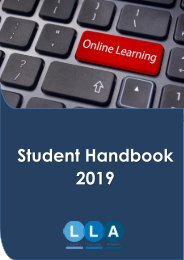CHSCM 3.0 - Unit 1 - SCM in the Humanitarian World
Learning Materials for Unit 1 of the Certification in Humanitarian Supply Chain Management (CHSCM).
Learning Materials for Unit 1 of the Certification in Humanitarian Supply Chain Management (CHSCM).
You also want an ePaper? Increase the reach of your titles
YUMPU automatically turns print PDFs into web optimized ePapers that Google loves.
<strong>in</strong>formation given to <strong>the</strong>m on strategies and plans. Good listen<strong>in</strong>g is also a skill. Good listen<strong>in</strong>g<br />
<strong>in</strong>volves:<br />
• Clear<strong>in</strong>g away thoughts and feel<strong>in</strong>gs from previous happen<strong>in</strong>gs and experiences and really<br />
focus<strong>in</strong>g on <strong>the</strong> person who is speak<strong>in</strong>g. Concentrate on <strong>the</strong>ir words and any non-verbal<br />
signals.<br />
• Active listen<strong>in</strong>g: active listen<strong>in</strong>g <strong>in</strong>volves giv<strong>in</strong>g <strong>the</strong> person full attention and convey<strong>in</strong>g to<br />
<strong>the</strong>m that you are listen<strong>in</strong>g. This will <strong>in</strong>volve mak<strong>in</strong>g eye contact and mak<strong>in</strong>g <strong>the</strong> occasional,<br />
non-evaluative verbal signs.<br />
• Attend<strong>in</strong>g to both <strong>the</strong> content <strong>in</strong> <strong>the</strong> words and <strong>the</strong> feel<strong>in</strong>gs beh<strong>in</strong>d <strong>the</strong>m; <strong>the</strong> words are not<br />
always <strong>the</strong> full message.<br />
• Positive listen<strong>in</strong>g: avoid prejudices or blocks to hear<strong>in</strong>g what <strong>the</strong> person is say<strong>in</strong>g.<br />
• Remember<strong>in</strong>g that hear<strong>in</strong>g someth<strong>in</strong>g that we disagree with will usually mean we stop<br />
listen<strong>in</strong>g or we will be formulat<strong>in</strong>g what we are go<strong>in</strong>g to say <strong>in</strong> response, and <strong>the</strong>refore not<br />
listen<strong>in</strong>g.<br />
When seek<strong>in</strong>g <strong>the</strong> commitment of people to supply cha<strong>in</strong> and program strategies and plans, we are<br />
go<strong>in</strong>g to f<strong>in</strong>d <strong>in</strong>itial resistance and lack of commitment from some people. To seek commitment<br />
from <strong>the</strong>se people will <strong>the</strong>refore <strong>in</strong>volve <strong>in</strong>fluenc<strong>in</strong>g <strong>the</strong>m that <strong>the</strong>y should support <strong>the</strong> particular<br />
strategies and plans. The skill of <strong>in</strong>fluenc<strong>in</strong>g is probably <strong>the</strong> communication skill that managers f<strong>in</strong>d<br />
<strong>the</strong> most difficult. It is a particularly important skill when try<strong>in</strong>g to <strong>in</strong>fluence someone who does not<br />
work directly for you.<br />
Influenc<strong>in</strong>g <strong>in</strong>volves persuad<strong>in</strong>g someone to agree to someth<strong>in</strong>g, or do someth<strong>in</strong>g that <strong>the</strong>y were<br />
not go<strong>in</strong>g to do. Influenc<strong>in</strong>g is not manipulat<strong>in</strong>g or trick<strong>in</strong>g someone <strong>in</strong>to do<strong>in</strong>g someth<strong>in</strong>g so that<br />
<strong>the</strong>y feel bad.<br />
The key to <strong>in</strong>fluenc<strong>in</strong>g is recogniz<strong>in</strong>g that successfully <strong>in</strong>fluenc<strong>in</strong>g someone requires <strong>the</strong> use of<br />
different styles of <strong>in</strong>fluence, depend<strong>in</strong>g upon:<br />
• The person(s) be<strong>in</strong>g <strong>in</strong>fluenced<br />
• The <strong>in</strong>fluenc<strong>in</strong>g situation<br />
The skill of <strong>in</strong>fluenc<strong>in</strong>g requires <strong>the</strong> ability to use different <strong>in</strong>fluenc<strong>in</strong>g styles, appropriate for <strong>the</strong><br />
person be<strong>in</strong>g <strong>in</strong>fluenced and <strong>the</strong> situation.<br />
We will look at <strong>the</strong> follow<strong>in</strong>g styles of <strong>in</strong>fluenc<strong>in</strong>g:<br />
• Personal<br />
• Assertive<br />
• Barga<strong>in</strong><strong>in</strong>g<br />
• Logical Persuasion
















